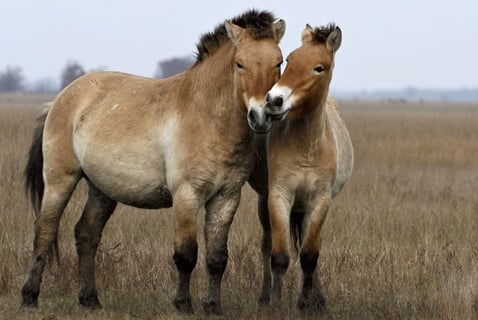
Its Wildlife Wednesday! This week we highlight the endangered Przewalski\’s horse – the last remaining wild horse breed.
It’s Wildlife Wednesday! This week we highlight the endangered Przewalski\’s horse of Mongolia—the last remaining wild horse breed in the world.
Habitat: the shrub-lands and plains of Mongolia, and Northern China
Przewalski\’s horse trivia
- Wondering where the name Przewalski\’s horse came from? They’re named after Przewalski, the Russian explorer who first discovered them.
- These horses are short, muscular, and stocky, with beige or red fur that becomes long and thick in the winter.
- A 2011 study showed that they are much more distantly related to domestic horses than researchers previously thought. They have ancient origins, and researchers hypothesize that their last shared ancestor with domestic horses lived 160,000 years ago.
- Like their domestic horse cousins, the Przewalski\’s horse munches on grass and other plants.
- They live in groups that have one head mare (female) and one head stallion (male), as well as other mares and offspring. Stallions are very protective of the mares in their group.
Why they’re threatened
Przewalski\’s horses were hunted for food, and much of their habitat was turned into farmland. At one time they were designated as extinct in the wild.
Thankfully, breeding efforts (including wildlife reserves in California and the Ukraine) have boosted the Przewalski\’s horse population. They were re-introduced into the wild in 1992 and are still being introduced. However, they are struggling with the grueling winters of the Gobi desert—the 2009/2010 winter, for instance, was the coldest in 50 years.
Approximately 1,500 Przewalski\’s horses exist today, but the vast majority live in captivity.
How to help Przewalski\’s horses
Conservation methods are still underway to protect the Przewalski\’s horse. Contact the World Wildlife Fund (WWF) Canada for more information about the Przewalski\’s horse and learn how you can help them.
Looking for more Wildlife Wednesday posts?
Check out these past posts:
- Leatherback sea turtles
- Sumatran tigers

